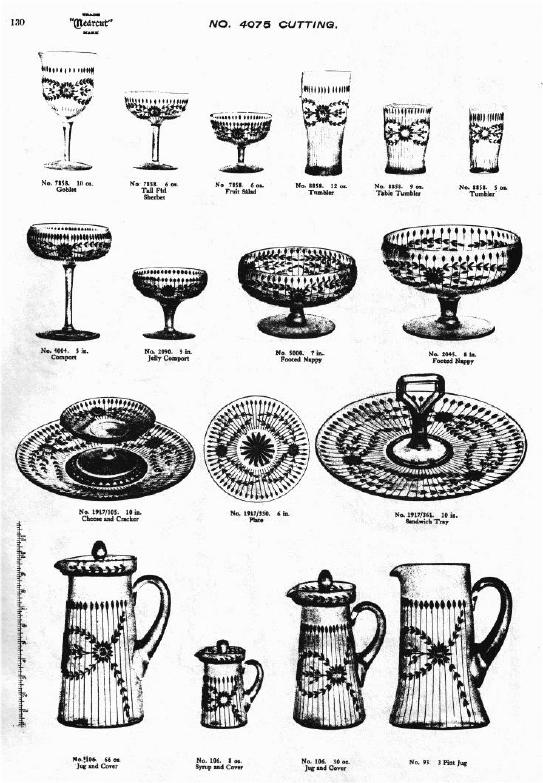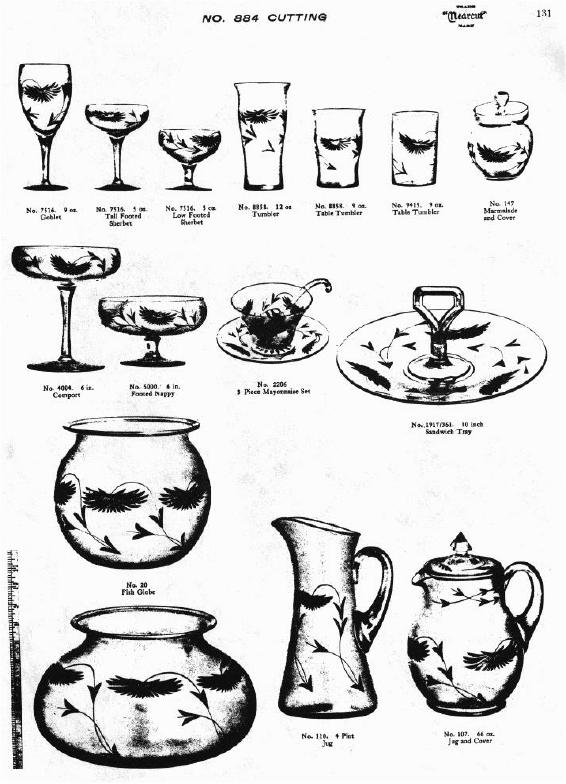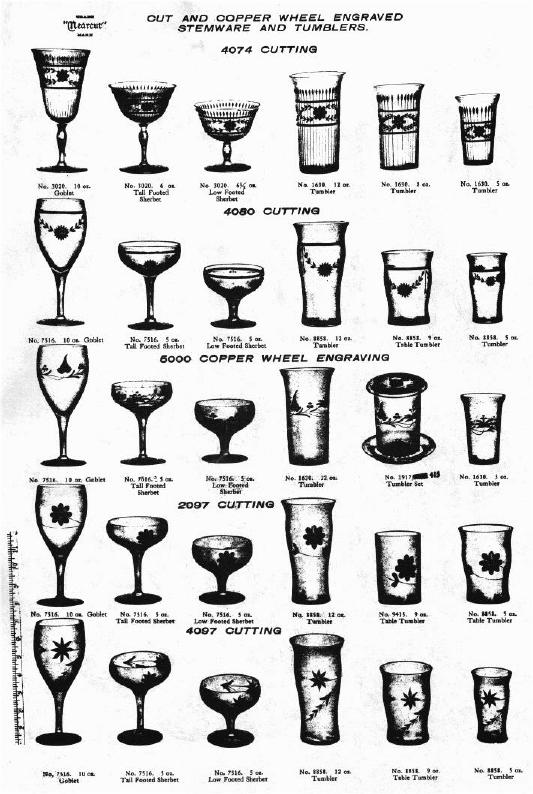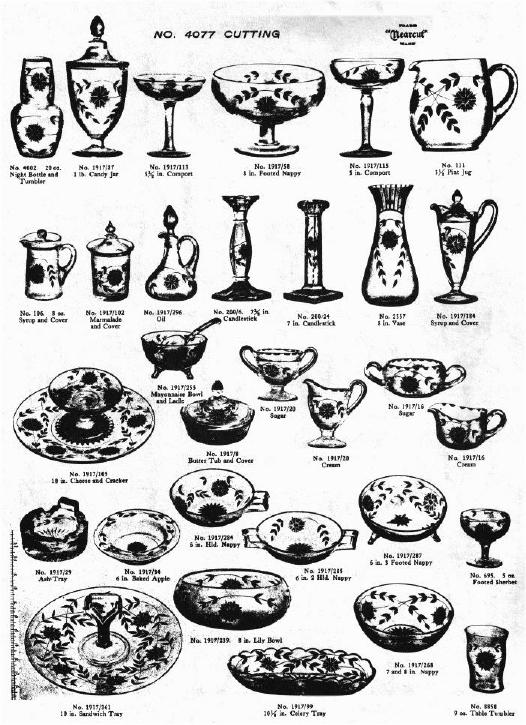"NEARCUT"- The Final Years of a Great Era
by Mark A. Nye
Issue No. 171 - July 1987
In recent years the term "Nearcut" has become synonymous with the
imitation pressed wares that Cambridge produced from the lighting of
the first furnace fires in 1902 until the early 1920s. In reality, the
term was simply a trademark, used in much the same manner as the later
![]()
According to previous research, the Nearcut trademark was in use by January 1904 and apparently was used as late as 1921-22. This period of some 18 years can be referred to as the Nearcut Era and during this period ware other than the imitation cut glass and early American or "Colonial" type was produced, especially during the last years of the mark's use.
The second half of the Nearcut Era saw the emergence of the first of the opaque colors, new transparent colors, an increasingly large inventory of plate etched goods and a lighter appearing style of tableware and accessory pieces as well. The use of the Plate etchings by Cambridge began circa 1913 with such patterns as #401 or Grape and #402 or Strawberry. A design patent for the latter was issued on November 11, 1913. During the next few years, various other etchings were put into use but none achieved lasting prominence until the coming of Marjorie in 1915. Quoting from Crockery and Glass Journal of May 13, 1915:
"Two rather elaborate but tasteful new etchings are being shown on night sets by D. King Irwin from the Cambridge Glass Co. One is a fuchsia and the other a rose" The fuchsia pattern, of course, being Marjorie.
The August 26, 1915 issue of Crockery and Glass Journal had this to say about Marjorie:
"Among the new attractions being displayed by D. King Irwin at the showroom of the Cambridge Glass Co. is a line of stemware tumblers and a variety of other pieces for table use that for daintiness would be difficult to improve upon. The shapes are well proportioned, exceedingly graceful, and exactly suited to the well-executed and prettily arranged Fuchsia pattern in a deep plate etching. The line is destined to take a prominent place among the productions of the firm."
January, 1916, saw the introduction of three colors, Ebony, Emerald Green and Royal Blue:
"Numbered among this season's new offerings are the Marjorie deep plate etching blown ware; emerald green vases and baskets, blown, pressed and cut floral items; light cut ware, vases and baskets; a fine array of Ebony Black novelties; flower bowls and flower holder blocks and some pieces in Royal Blue."
"D. King Irwin is showing a comprehensive line of colored glass from the Cambridge Glass Co. that is noteworthy in many respects. Besides a fine assortment of black - plain as well as richly decorated in raised enamel - there are lines of blue and green that are very pleasing" With the exception of Ebony which remained a constant color, the other two should be referred to as early dark Emerald and early Royal Blue as both names were used in later years for different formulations and in the case of Emerald, reused not once but twice.
Then in June 1916, came the fourth color of that year, Mulberry:
"The 'Mulberry' line of glassware being shown by D. King Irwin from the Cambridge Glass Co. is proving one of the successes of the season. The richness of the color and the long list of pieces are factors that are making it so popular. There are odd shapes in stemware in solid Mulberry color; also with crystal bowls and mulberry stems, vases, comports, baskets, Chinese footed bowls, jugs with and without covers, loving cups, iced tea and lemonade glasses." And once again we have a color name that was destined to be reused. Hence it is recommended this color be referred to as early Mulberry. This color, along with the preceding three were advertised under the Nearcut trademark.
Returning to etchings, we have the following from the June 23, 1921 issue of Crockery and Glass Journal:
"It would be difficult to select a more tasteful table service than from any of the three beautiful etched patterns the "Dresden","Adam" or "Wedgewood". Cambridge is now showing the complete assortment of items made in each design - which consists of considerably more than the usual number of articles to be found in lines of this character. For instance, besides stemware and all the things one would ordinarily use in an every day table service, there are candlesticks, cheese and cracker dishes, flower bowls, cake plates, covered comports, iced tea sets, syrup jugs, candy jars, etc."
Thus with these three etchings we have the first of the extensive lines of etched ware, a trend that was to culminate with Elaine and Rose Point in the 1930s and 1940s. Prior to this, etched lines were relatively small, even Marjorie was limited mainly to stemware, tumblers and associated items.
Also brought out under the Nearcut trademark was the etching Cleo, destined to last well into the 1930s, and the opaque color Azurite.
"The Cambridge Glass Co. are certainly to be congratulated on the attractiveness of their showroom, together with the beauty of the various new lines now on display. Of first consideration is "Azurite", a sky blue glass of most odd and attractive solid color. Vases, bowls, comports, candlesticks, etc., are some of the items of this popular line which also comes in gold encrustations with various decorations and also with a brown iridescent finish. "Azurite" also comes decorated in green and brown with deep etched borders, a most delicate offering." China, Glass and Lamps, March 20, 1922.
While usage of the Nearcut trademark in trade publications had for all practical purposes ceased by this time, Cambridge catalog pages, including those showing the items being produced in Azurite still bore the mark.
The Crockery and Glass Journal of February 16, 1922 had this to say about the Cambridge Glass Co. and its wares:
"... has many new things to show the trade. One of these is the factory's "Azurite" which recently attracted so much attention at the Pittsburgh Exhibit. It introduced a fascinating shade of blue, with a variety of very rich encrustation decorations. Black peacocks and dragons are also a very striking contrast as another decoration. These are also used to advantage in a harmonious shade of green. This line is shown in many excellent items such as bowls, comports, candy jars, candlesticks, flower and fruit centers and a variety of other articles ..."
The last of the Nearcut Era catalogs was Catalog #10 and with it a decided change is noted. The predominance of the imitation cut glass so closely associated with the term Nearcut is gone.
Granted, some of the old patterns such as Wheat Sheaf, Buzz Saw and Plymouth were still featured in this catalog. In addition to these, we see the Plain Ware or 1917 Line prominently shown.
Plain Ware is exactly that, being very simple lines and style. We see more thin blown stemware and tumblers and several etchings including Cleo, Betty and Martha, all three of which were introduced under the Nearcut trademark.
It is also in Catalog #10 and under the Nearcut trademark that cut and copper wheel engraved wares begin to appear with more sophisticated patterns and while not equal to the designs produced in the 1930s, several of the cuttings are indicative of things to come from the Cambridge factory.
(EDITOR'S NOTE: The four catalog pages shown with this article are taken from Catalog #10.)




